Papers by Abdurrahim Ayğan
İslam tetkikleri dergisi, Sep 27, 2023
Endülüs Kenti İşbiliye’nin Estetik Dokusunun Tarihsel Dönüşümüne Dair Bir Araştırma, 2023
Sanat Tarihinde Bir Sınıflandırma Biçimi Olarak İslam Sanatı ve Geleneksel Sanatlar

Mevzu – Sosyal Bilimler Dergisi
14. yüzyılın ilk çeyreğinde İlhanlı yönetimindeki Tebriz kültürel bir can-lanmaya sahne olmuştur.... more 14. yüzyılın ilk çeyreğinde İlhanlı yönetimindeki Tebriz kültürel bir can-lanmaya sahne olmuştur. Bu dönemde Gazan Han ve Vezir Reşîdüddin Fazlullah’ın öncülüğünde resimli el yazmaları hazırlanmıştır. İlhanlıların Uzak Doğudan Ön Asya’ya uzanan yayılma stratejisi ve birçok kültürle kurdukları dinamik ilişkiler, Câmiü’t-tevârih ve el-Âsârü’l-bâkiye gibi farklı milletleri, kültürleri ve inançları içeren iki önemli resimli eserin ortaya çıkışının zeminini hazırlamıştır. İlhanlı dönemine kadar İslam tarih yazıcılığında bir hanedan gözetiminde kapsam itibariyle üniversal bir proje görülmemişti. Bu eserlerdeki resimler uzak Asya’dan batı dünyasına uzanan zengin bir ikonografik konsepte sahiptir. Bu sebeple İlhanlı resim sanatıyla ilgili temel problem ikonografik kaynaklar olmuştur. Hıristiyan kültürü ve resim geleneği kaynakların başında gelmektedir. Özellikle eski peygamberlerin betimlemelerinde Hıristiyan ikonografyasının etkileri doğal olarak görülmektedir. Fakat bunlar arasında İsa’nı...

Trabzon İlahiyat Dergisi
13. yüzyıl, İslam coğrafyasında mushafların yazımı ve tasarımında belirgin bir değişimin gözlemle... more 13. yüzyıl, İslam coğrafyasında mushafların yazımı ve tasarımında belirgin bir değişimin gözlemlendiği dönemdir. Moğol istilası ile haçlı seferlerinin sebep olduğu kültürel tahribat, değişen haritalar ve istila sonrasında Memlük ve İlhanlıların kültürel politikaları bu değişimin tarihsel arka planını oluşturmaktadır. 13. yüzyılda Moğol ve haçlı ordularına karşı direnen ve askeri bir güç olarak ortaya çıkan Memlükler, izledikleri kültürel politikalarla Orta Çağ sanatı içerisinde belirgin bir konuma sahip olmuştur. Memlük sultanları için bir mushafın tasarımı bir ibadet mekânının tasarlanması kadar değerli olmalıydı ki bu dönemde hazırlanmış sanatlı birçok Kur’ân günümüze ulaşmıştır. Bu çalışmada Diyanet İşleri Başkanlığı Merkez Kütüphanesi’nde korunan ve katalog bilgilerinde Memlük dönemine tarihlendirilen üç mushaf kitap sanatları açısından incelenmiştir. Bunlardan ilki olan DİB 6342 numarayla kayıtlı mushaf eksiksiz olarak günümüze ulaşmıştır. Ketebe kaydı bulunmamasına karşın eser...

Art-e Sanat Dergisi
Bu çalışma İran coğrafyasının kadim Türk topluluklarından biri olan Kaşkaylara mensup ressam Bija... more Bu çalışma İran coğrafyasının kadim Türk topluluklarından biri olan Kaşkaylara mensup ressam Bijan Bahadori Keşkuli'nin sanat anlayışına odaklanmıştır. Kaşkaylar atalarından devraldıkları sözlü mirası, el sanatlarını, inanç biçimlerini, töre ve geleneklerini modern zamanlara kadar taşımışlardır. Kaşkay kültürünün bu yalın hali özellikle antropologların dikkatini çekmiş ve bu konuda araştırmalar yapmışlardır. Fakat eserleri bugün İran ve Avrupa’nın farklı müze ve özel koleksiyonlarında yer alan ressam Bijan Bahadori hakkında herhangi bir müstakil çalışma yapılmamış ve antropolojik çalışmalarda da eserlerine değinilmemiştir. Bijan Bahadori Keşkuli’nin bütün eserleri kendi kültürüne ait belge niteliği taşıyan çalışmalardır. 1970’lerden sonra hızla değişen ve modernleşmeye başlayan Kaşkayların geleneksel sosyal yapısına dair birçok unsuru kaydetmeyi başarmıştır. Kaşkay kültürü, gelenekleri, ritülleri, merasimleri ve göçebe yaşam pratikleri resimlerinin ana temalarındandır. Çok iyi b...

Şarkiyat mecmuası, Apr 28, 2023
Islamic book art is an art branch that has developed around the courts since its inception. For t... more Islamic book art is an art branch that has developed around the courts since its inception. For this reason, imagining book art independent of the political history of palaces or the identity of a dynasty is impossible. Therefore, book art research requires multi-layered studies. In addition to the physical qualities of the manuscripts studied in such research, their artistic features regarding binding, illumination, and calligraphy also bear the traces of the sociocultural conditions of the period. This research focuses on the mushafs of the Mamluk period and attempts to determine the processes that had affected the production of mushafs within the framework of the social dimensions of art. In the 13th century when the Mamluks had emerged as a military power, the Islamic geography witnessed events that could be considered turning points. The first of these was the crusades that had threatened Muslim dynasties such as the Seljuks, Fatimids, and Ayyubids since the 11th century. The Mongol invasion from the east added to this threat from the west. Thus, the Islamic geography faced threats from both the west and the east in the 13th century. The Mamluks struggled with both powers and rose to a prestigious position in the Islamic world. They held cities such as Cairo, Aleppo, and Damascus and increased their political and cultural positions. In particular, the plundering of Baghdad as a result of Mongol attacks and the termination of the Abbasid caliphate had had dramatic effects on the Islamic world. The Mamluks reestablished the sacred sequence by appointing a dynasty member of the Abbasid lineage as caliph in Cairo. Similar efforts by the Mamluks to politically repair the destruction are also seen in the cultural field. The destruction of the Baghdad libraries by the Mongols caused the sultans to provide special value to writing the Qur’an. In this period, mausoleums and zawiyas called khanqahs were built in Cairo, Aleppo, and Damascus with the influence of rising mystical movements. These institutions and foundations the Mamluks are among the other factors that kept the mushaf writing alive. The sultans endowed a quality to the Qur’ans they had prepared specially for these foundations. One of the elements shaping Qur’anic art during the Mamluk dynasty was the dynasty’s slave identity. The dynastic identity was not based on any great lineage, and this caused legitimacy crises. Intense throne fights and short-term changes to the throne throughout the Mamluk history must have been a result of this. Accordingly, the sultans can be said to have supported the production of manuscripts for legitimacy, especially the writing of mushafs, because books were as valuable and influential as grandiose monuments in the Middle Ages. For this reason, the Mamluk political history, the political origins of the dynasty, and its institutional structures are the three interconnected pillars that shaped the art of mushaf. Most of the mushafs that have survived from the Mamluk period are dated after the 14th century. Why so few copies of the Qur’an have survived to the present from the first 50 years of the Mamluk dynasty is one of the questions that should be asked within the framework of this subject, and political history can help clarify this, because in the first 50 years, the Mamluks had been struggling with the crusader and Mongol invasions. The writing of mushafs is seen to have gained momentum at the beginning of the 14th century. One of the rare copies of the Qur’an that have survived from this period is the seven-volume Qur’an prepared for the Sultan Baibars and exhibited in the British Museum. This work sheds light on Mamluk mushaf art in many aspects. The style of writing is called Thuluth al-Ashar and had never been tried before; it involves ornate illuminations and enlightens one about the aesthetics of the Mamluk palace. In addition, the physical characteristics of this early work show that it had been prepared for the purpose of being donated to an institution built by order of the Sultan. One of the problems about Mamluk mushaf art is related to the development periods of illumination during the period. Decoration formats consisting of multi-pointed stars encountered in Seljuk art had frequently been applied to the zahriyah [back] pages of Mamluk mushafs. Toward the end of the 14th century, the artist Muzahhib Ibrahim Amidi the Illuminator went beyond this classical decorative format and adopted a style that focused on detailed plant forms. Two different styles are seen to have continued throughout the 15th century. As a result, the periods related to the mushaf decoration formats are not exactly clear. Research on the Qur’an is scattered among different museums and libraries around the world today and will facilitate answers to these questions.

Şarkiyat Mecmuası, 2023
Islamic book art is an art branch that has developed around the courts since its inception. For t... more Islamic book art is an art branch that has developed around the courts since its inception. For this reason, imagining book art independent of the political history of palaces or the identity of a dynasty is impossible. Therefore, book art research requires multi-layered studies. In addition to the physical qualities of the manuscripts studied in such research, their artistic features regarding binding, illumination, and calligraphy also bear the traces of the sociocultural conditions of the period. This research focuses on the mushafs of the Mamluk period and attempts to determine the processes that had affected the production of mushafs within the framework of the social dimensions of art. In the 13th century when the Mamluks had emerged as a military power, the Islamic geography witnessed events that could be considered turning points. The first of these was the crusades that had threatened Muslim dynasties such as the Seljuks, Fatimids, and Ayyubids since the 11th century. The Mongol invasion from the east added to this threat from the west. Thus, the Islamic geography faced threats from both the west and the east in the 13th century. The Mamluks struggled with both powers and rose to a prestigious position in the Islamic world. They held cities such as Cairo, Aleppo, and Damascus and increased their political and cultural positions. In particular, the plundering of Baghdad as a result of Mongol attacks and the termination of the Abbasid caliphate had had dramatic effects on the Islamic world. The Mamluks reestablished the sacred sequence by appointing a dynasty member of the Abbasid lineage as caliph in Cairo. Similar efforts by the Mamluks to politically repair the destruction are also seen in the cultural field. The destruction of the Baghdad libraries by the Mongols caused the sultans to provide special value to writing the Qur’an. In this period, mausoleums and zawiyas called khanqahs were built in Cairo, Aleppo, and Damascus with the influence of rising mystical movements. These institutions and foundations the Mamluks are among the other factors that kept the mushaf writing alive. The sultans endowed a quality to the Qur’ans they had prepared specially for these foundations. One of the elements shaping Qur’anic art during the Mamluk dynasty was the dynasty’s slave identity. The dynastic identity was not based on any great lineage, and this caused legitimacy crises. Intense throne fights and short-term changes to the throne throughout the Mamluk history must have been a result of this. Accordingly, the sultans can be said to have supported the production of manuscripts for legitimacy, especially the writing of mushafs, because books were as valuable and influential as grandiose monuments in the Middle Ages. For this reason, the Mamluk political history, the political origins of the dynasty, and its institutional structures are the three interconnected pillars that shaped the art of mushaf. Most of the mushafs that have survived from the Mamluk period are dated after the 14th century. Why so few copies of the Qur’an have survived to the present from the first 50 years of the Mamluk dynasty is one of the questions that should be asked within the framework of this subject, and political history can help clarify this, because in the first 50 years, the Mamluks had been struggling with the crusader and Mongol invasions. The writing of mushafs is seen to have gained momentum at the beginning of the 14th century. One of the rare copies of the Qur’an that have survived from this period is the seven-volume Qur’an prepared for the Sultan Baibars and exhibited in the British Museum. This work sheds light on Mamluk mushaf art in many aspects. The style of writing is called Thuluth al-Ashar and had never been tried before; it involves ornate illuminations and enlightens one about the aesthetics of the Mamluk palace. In addition, the physical characteristics of this early work show that it had been prepared for the purpose of being donated to an institution built by order of the Sultan. One of the problems about Mamluk mushaf art is related to the development periods of illumination during the period. Decoration formats consisting of multi-pointed stars encountered in Seljuk art had frequently been applied to the zahriyah [back] pages of Mamluk mushafs. Toward the end of the 14th century, the artist Muzahhib Ibrahim Amidi the Illuminator went beyond this classical decorative format and adopted a style that focused on detailed plant forms. Two different styles are seen to have continued throughout the 15th century. As a result, the periods related to the mushaf decoration formats are not exactly clear. Research on the Qur’an is scattered among different museums and libraries around the world today and will facilitate answers to these questions.
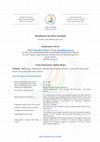
Şırnak Üniversitesi İlahiyat Fakültesi Dergisi, 2022
Günümüze ulaşan örneklere göre Mushaf yazımı 8. yüzyılda Emeviler devrinde sistemli hale gelmiş, ... more Günümüze ulaşan örneklere göre Mushaf yazımı 8. yüzyılda Emeviler devrinde sistemli hale gelmiş, Abbasiler döneminde Bağdat’taysa yazı ve süsleme açısından büyük bir gelişim kaydetmiştir. 13. yüzyılın ortalarında İslam kültür ve medeniyetini derinden etkileyen Moğol istilası Bağdat’taki mushaf yazım geleneğinin bir süre sekteye uğramasına sebebiyet vermiştir. Henüz kuruluş aşamasında Moğollarla savaşarak onların ilerleyişini durduran Memlükler bu dönemde İslam dünyasında bir güç olarak ortaya çıkmıştır. Başşehir olan Kahire’nin ardından Suriye’yi de topraklarına katarak bu iki şehri kültür merkezi haline getirmişlerdir. 14. yüzyıla girildiğinde Kahire ve Şam’da gerek yazı gerek süsleme açısından nitelikli mushaflar hazırlanmıştır. Özellikle sultanların himayesinde hazırlanan Kur’anlar, Memlük dönemi kurumsal yapıları, sosyo-kültürel kimliği hakkında ışık tutan bir hikâyeye sahiptir. Günümüzde sayısını henüz bilemediğimiz ciltlerce mushaf dünyanın farklı müze ve kütüphanelerinde koru...
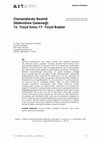
Araştırma Makalesi Osmanlılarda Resimli Silsilenâme Geleneği: 16. Yüzyıl Sonu-17. Yüzyıl Başları ... more Araştırma Makalesi Osmanlılarda Resimli Silsilenâme Geleneği: 16. Yüzyıl Sonu-17. Yüzyıl Başları ÖZ Osmanlı hanedanının soyu erken dönem tarih kitapları içerisinde yer almasına karşın, soyağacı tarzında şematik biçimli dünya tarihi tarzındaki ilk silsilenâme II. Bayezid (1481-1512) dönemine tarihlendirilir. Resimsiz ve küçük boyutlu olan bu eserle birlikte bu türün Osmanlılarda geç dönemlere kadar gelişimini sürdürdüğünü söylemek mümkündür. Devletin imparatorluğa dönüştüğü ve politik kimliğinin evrildiği Kanuni döneminde bu türe ilginin arttığı, silsilenâmelerin çeşitlendiği görülmektedir. Derviş Mehmed bin Ramazan, Yusuf bin Abdullatif ve Şerif Şefii gibi tarihçiler gerek rulo gerekse de kitap şeklindeki silsileleri bu dönemde vücuda getirmişlerdir. 16. yüzyıl sonları ile 17. yüzyıl başlarında bu türde sıra dışı bir hareketlilik dikkati çeker. 16 yüzyıl ortalarında sarayda hazırlanan örneklerden farklı olarak sultanların portre madalyonlarını içeren bu silsilenâmeler, Osmanlının bir eyaleti olan Bağdat'ta üretilmiştir. Bağdatlı silsile tasarımcıları bu eserlerde radikal bir değişikliğe giderek yatay yerine dikey soy çizgilerine dayanan bir modeli benimsemiştir. Bunun yanı sıra her biri tek elden çıkmış gibi standart tasarım ve kurguya sahip olmaları bu eser grubunu farklı kılmaktadır. Bu sebeple aynı tarihlerde belirli motivasyonla hazırlanan silsilelerin bir bütün olarak ele alınması gerekmektedir. Bu çalışmada odaklandığımız husus resimli nüshalar temel alınarak Bağdat'ta hazırlanan bu eserleri kurgu ve tasarım açısından incelemek ve İslam dünyasında hazırlanan önceki örnekler arasındaki farklılıkları ortaya koymaktır.
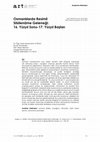
Araştırma Makalesi Osmanlılarda Resimli Silsilenâme Geleneği: 16. Yüzyıl Sonu-17. Yüzyıl Başları ... more Araştırma Makalesi Osmanlılarda Resimli Silsilenâme Geleneği: 16. Yüzyıl Sonu-17. Yüzyıl Başları ÖZ Osmanlı hanedanının soyu erken dönem tarih kitapları içerisinde yer almasına karşın, soyağacı tarzında şematik biçimli dünya tarihi tarzındaki ilk silsilenâme II. Bayezid (1481-1512) dönemine tarihlendirilir. Resimsiz ve küçük boyutlu olan bu eserle birlikte bu türün Osmanlılarda geç dönemlere kadar gelişimini sürdürdüğünü söylemek mümkündür. Devletin imparatorluğa dönüştüğü ve politik kimliğinin evrildiği Kanuni döneminde bu türe ilginin arttığı, silsilenâmelerin çeşitlendiği görülmektedir. Derviş Mehmed bin Ramazan, Yusuf bin Abdullatif ve Şerif Şefii gibi tarihçiler gerek rulo gerekse de kitap şeklindeki silsileleri bu dönemde vücuda getirmişlerdir. 16. yüzyıl sonları ile 17. yüzyıl başlarında bu türde sıra dışı bir hareketlilik dikkati çeker. 16 yüzyıl ortalarında sarayda hazırlanan örneklerden farklı olarak sultanların portre madalyonlarını içeren bu silsilenâmeler, Osmanlının bir eyaleti olan Bağdat'ta üretilmiştir. Bağdatlı silsile tasarımcıları bu eserlerde radikal bir değişikliğe giderek yatay yerine dikey soy çizgilerine dayanan bir modeli benimsemiştir. Bunun yanı sıra her biri tek elden çıkmış gibi standart tasarım ve kurguya sahip olmaları bu eser grubunu farklı kılmaktadır. Bu sebeple aynı tarihlerde belirli motivasyonla hazırlanan silsilelerin bir bütün olarak ele alınması gerekmektedir. Bu çalışmada odaklandığımız husus resimli nüshalar temel alınarak Bağdat'ta hazırlanan bu eserleri kurgu ve tasarım açısından incelemek ve İslam dünyasında hazırlanan önceki örnekler arasındaki farklılıkları ortaya koymaktır.
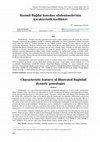
Kayseri Üniversitesi Sosyal Bilimler Dergisi, 2020
Silsilenâmeler, Osmanlı minyatür sanatında tarih konulu eserler grubuna giren bir türdür. Bu eser... more Silsilenâmeler, Osmanlı minyatür sanatında tarih konulu eserler grubuna giren bir türdür. Bu eserlerde Âdem'den başlanarak, peygamberler, krallar ve sultanlar, aralarındaki soy ilişkisi gözetilerek daireler içerisinde temsil edilir. En sonda ise Osmanlı hanedanı bir dizi halinde sıralanır. Osman Gazi'den başlayan bu dizi, el yazmasının hazırlandığı dönemde saltanatı süren sultana kadar devam eder. Silsilenâmeler iki ana bölümden oluşmaktadır. Birinci bölümde dünya tarihinin kısa bir özeti sunulur, ikinci bölümde ise ilk insan Âdem'den başlayan ve Osmanlı hanedanının son üyesiyle son bulan bir şematik dizi yer alır. Resimsiz silsilenâmelerde dairelerin içerisine hükümdarların adları yazılır, resimli örneklerde ise madalyonlar içerisine portreleri çizilir. Silsilenâmeler iki farklı edebî geleneğin birleşimi olarak ele alınabilir. Öncelikle bu eserler, bir hanedanın soyunu ele alan bir şeceredir. Bunun yanı sıra, ilk insandan başlamak üzere çeşitli dönemleri, yazıldığı tarihe kadar anlatan bir dünya tarihi niteliği taşır. Silsilenâmeleri sanat tarihi açısından resimli ve resimsiz olmak üzere iki gruba ayırmak mümkündür. Farklı dönemlere ait birçok resimsiz Silsilenâme nüshası mevcuttur. Tespit edilen resimli nüshalar ise 13-14 civarındadır. Osmanlılarda resimli ilk örnekler Osmanlının Bağdat eyaletinde 16. yüzyıl sonlarında ortaya çıkmıştır. Çalışmamızda Bağdat'ta hazırlanmış resimli örnekleri, Topkapı Saray Müzesi Kütüphanesi'nde kayıtlı dört nüsha (TSMK H. 1324, TSMK H. 1591, TSMK A. 3110, TSMK H. 1624) ile Dublin Chester Beatty Library'de (CBL. T. 423) bulunan bir nüsha çerçevesinde inceleyeceğiz.
Giriş
1. Sanat Antropolojisinde Yöntem Sorunu
2. Sanat Antropolojisi Nedir?
3. Türk Sanatını... more Giriş
1. Sanat Antropolojisinde Yöntem Sorunu
2. Sanat Antropolojisi Nedir?
3. Türk Sanatının Antropolojisi
4. Göçebelikten Kentliliğe Adım: Uygur Prensi ve
Maniheist Protokol
5. Bey’den İmparator’a Geçiş: TSM H. 2153 Albümündeki Sultan Fatih Portresi
6. Aydınlanmanın Zaferi: Osman Hamdi Bey’in Yaradılış
(Mihrab) Tablosu
7. Sonuç
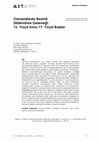
ARTS, 2020
Although the lineage of the Ottoman dynasty is included in the early
history books, the frst sils... more Although the lineage of the Ottoman dynasty is included in the early
history books, the frst silsilenâme in the schematic world history style,
belongs to the period of Bayezid II (1481-1512). It is possible to say that
this species continues its development until the late periods in the
Ottoman Empire with this small and non-pictured work. It is observed
that during the reign of Süleyman I (1520-66), when the state was
transformed into an empire and its political identity evolved, the interest
in this species increased and the genealogies diversifed. Historians
such as Derviş Mehmed bin Ramazan, Yusuf bin Abdullatif and Şerif
Şefi, created genealogies in roll and book format in this period. An
extraordinary mobility draws attention in this spieces in the late 16th
and early 17th centuries. Unlike the examples prepared at the court
in the mid-16th century, these genealogies which contain portrait
medallions of the sultans were produced in Baghdad, a province of
the Ottoman Empire. The main invention of the Baghdad genealogy
producers is that they have adopted a model based on vertical lineage
rather than horizontal making a radical change in the page design. In
addition, the fact that they each have standard design and fction as
if they were from one hand, makes this manuscript group different. For
this reason, these works prepared with certain motivation on the same
dates should be considered as a whole. Our focus in this study is to
examine these works prepared in Baghdad on the basis of illustrated
copies in terms of fction and design and to reveal the differences
between previous examples prepared in the Islamic world.
Keywords: ottoman genealogy, genealogic tree, miniature, islamic
painting, ottoman manuscripts

2. ULUSLARARASI AVRASYA TÜRK SANATLARI KONGRESİ, 2015
Turkish Buddhist painting, which began with Gokturks and reached its peak in Uyghur
period, invol... more Turkish Buddhist painting, which began with Gokturks and reached its peak in Uyghur
period, involves a rich iconograpy. Graphical painting sytle, which bear the traces of rock
paintings and various iconographic elements are the distinguishing features of this period.
Turkish Buddhist iconography in general, is a mixture of traditional beliefs, Turkish mythology and Buddhist metaphysics. Though it can be said that the iconography of this period
is diverse, the predominant element in those mural painting is the Buddhist faith.
The main centre of the Buddhist iconography is Nirvana and this thought, the Buddhist
version version of enlightenment idea, is also known as Moksha in Hinduism. Nirvana and
Moksha refer to the idea of salvation in Asiatic society. Salvation is multifaceted term that
contains philosophical, religious and political meaninga and therefore, it has been existed
in many different societies. The term of Salvation in Buddhism can be define the release from
repetitive cycle of birth called Samsara. Buddha Sakyamuni, the founder of the religion, is
regarded as an idol in the way to salvation. For this reason, his story of salvation becomes a
series of rules which believers should follow.
The traces of the story of Buddha’s journey to nirvana is clearly seen in the Turkish Buddhist painting. The enlightenment stories of other Saintly figures such as Boddhisattva, Deva
and etc. are important in a way similar to Buddha’s journey. Meditation scene, hand gesture
known as Mudra, Buddha’s facial expression, mandala and lotus are important elements that
give us marks of salvation imagery in the Turkish Buddhist art.
In the illustrated Islamic manuscripts, the concept of Salvation is represented by the ship
symbolism which carries important symbolic significations. Scene which includes ships
controlled by the Saints and their rescue of people from the stormy sea are common in the
illustrated Islamic manuscripts. In this regard, most populer two examples are Noah’s ark
and ehl-i Beyt ship.
Our purpose in this study is to evaluate imagery of salvation in the Turkish Buddhist painting and Islamic painting and to reveal comparative iconological results.
Keywords: Uyghur Painting, Buddhist Iconography, Nirvana, Salvation, Ship Symbolism
Anahtar Kelimeler: Uygur Resim Sanatı, Budist İkonografi, Nirvana, Kurtuluş, Gemi
Sembolizmi

1. Uluslararası Avrasya Türk Sanatları Kongresi Bildiriler (21- 24 Kasım 2012), ed. Yaşar Çoruhlu, Hâlenur Katipoğlu, J. Özlem Oktay, MSGSÜ Türk Sanatı Tarihi Uygulama ve Araştırma Merkezi, İstanbul: 2014, s. 115-129., 2014
Buddhism was a major religion that affects social and cultural life of the Turks beginning from G... more Buddhism was a major religion that affects social and cultural life of the Turks beginning from Göktürk period. Although Manhasm was adopted Uyguran noble, the mpact of Buddhsm had continued among the people at that tme. These religions had a major mpact on the Turksh pantng art n the Pre-Islamc perod. Pre-İslamic Central Asan Turkish painting includes a rch religious conography. The walls of the temple ornamented wth Buddhst and manhast sacred scenes during the Göktürk (552-744 AD) and Ughur perod (745-840 AD). The scenes of wall pantngs and miniatures provded connection between believers and sants. İn ths scenes religious characters that messages gven through them have descrptve features. Because of these reasons, forms of posture and clothes, facial and hand expressions, anmals and objects were depcted wth them are determinies the man iconographc elements. Although vsual depiction of the sants prohbted n the slamc perod, İslamc mystcs that origin Asan Turksh such as Mevlevis, Kalenders and Baraks produced very splendd examples of the painting art. İn ths examples they depcted ther teachng and sacred characters. İt may be argue that the rich tradition of pre-İslamic asan Turkish painting to have mpact on the development İslamc pantng and mystc art style. Postures of religious characters n mnatures, ndstnct ther facal expressons, mysterous hands (hidden hands in the sleeve) and draped clothes shows that pre-Islamc Asan Turksh religious conography is maintaned by the Islamic mystcs.
Books by Abdurrahim Ayğan

2. Uluslararası Nuh Tufanı ve Cudi Dağı Sempozyumu, 2021
The subject of this study is the miniatures in the illustrated
manuscripts of the late Middle Age... more The subject of this study is the miniatures in the illustrated
manuscripts of the late Middle Ages, which are about the story of Noah. In
the first quarter of the 14th century, one of the first examples of illustrated
general historiography emerged with the work of Câmiü't-tevârih, which
was prepared under the auspices of the Ilkhanid court. The Timurids, who
took over this cultural accumulation from the Ilkhanids, revived this
understanding a century later with the work of Mecmaü't-tevarih. In both
works, the stories of the Biblical prophets are handled as a separate section and these stories are illustrated. The story of the Prophet Noah is among the illustrated copies of Câmiü't-tevârih and Mecmâü't-tevarih that have survived to the present day. In this study, the iconographic development of the story of the Prophet Noah in the medieval illustrated manuscripts will be examined within the text-illustration relationship. Iconographic differences in the miniatures will be identified and focused on the relationship of these differences with texts and narratives that have taken place over time in the memory of society.
Keywords: Islamic Painting Art, Miniature, Noah's Flood, Noah's Ark,
Ilkhanate.
Zeren Tanındı Armağanı: İslam Dünyasında Kitap Sanatı ve Kültürü / Zeren Tanındı Festschrift: Art and Culture of Books in the Islamic World, ed. Aslıhan Erkmen, Şebnem Tamcan Parladır (İstanbul: Lale Yayıncılık, 2022)., 2022
Yazıların sorumlulukları yazarlara aittir. Kitaptaki metin ve resimlerin, tamamının veya bir kısm... more Yazıların sorumlulukları yazarlara aittir. Kitaptaki metin ve resimlerin, tamamının veya bir kısmının, elektronik, mekanik, fotokopi veya herhangi bir kayıt sistemi ile çoğaltılması, yayımlanması ve depolanması, başka dillere çevrilmesi yayıncıdan ve ilgili müze müdürlükleri ve kurumlardan alınacak yazılı izne tabidir. Lale Yayıncılık, Lale Organizasyon Ticaret Limited Şirketi'nin markasıdır. Bu kitabın yayın hakları Lale Yayıncılık ve Lale Organizasyon'a aittir.
Uploads
Papers by Abdurrahim Ayğan
1. Sanat Antropolojisinde Yöntem Sorunu
2. Sanat Antropolojisi Nedir?
3. Türk Sanatının Antropolojisi
4. Göçebelikten Kentliliğe Adım: Uygur Prensi ve
Maniheist Protokol
5. Bey’den İmparator’a Geçiş: TSM H. 2153 Albümündeki Sultan Fatih Portresi
6. Aydınlanmanın Zaferi: Osman Hamdi Bey’in Yaradılış
(Mihrab) Tablosu
7. Sonuç
history books, the frst silsilenâme in the schematic world history style,
belongs to the period of Bayezid II (1481-1512). It is possible to say that
this species continues its development until the late periods in the
Ottoman Empire with this small and non-pictured work. It is observed
that during the reign of Süleyman I (1520-66), when the state was
transformed into an empire and its political identity evolved, the interest
in this species increased and the genealogies diversifed. Historians
such as Derviş Mehmed bin Ramazan, Yusuf bin Abdullatif and Şerif
Şefi, created genealogies in roll and book format in this period. An
extraordinary mobility draws attention in this spieces in the late 16th
and early 17th centuries. Unlike the examples prepared at the court
in the mid-16th century, these genealogies which contain portrait
medallions of the sultans were produced in Baghdad, a province of
the Ottoman Empire. The main invention of the Baghdad genealogy
producers is that they have adopted a model based on vertical lineage
rather than horizontal making a radical change in the page design. In
addition, the fact that they each have standard design and fction as
if they were from one hand, makes this manuscript group different. For
this reason, these works prepared with certain motivation on the same
dates should be considered as a whole. Our focus in this study is to
examine these works prepared in Baghdad on the basis of illustrated
copies in terms of fction and design and to reveal the differences
between previous examples prepared in the Islamic world.
Keywords: ottoman genealogy, genealogic tree, miniature, islamic
painting, ottoman manuscripts
period, involves a rich iconograpy. Graphical painting sytle, which bear the traces of rock
paintings and various iconographic elements are the distinguishing features of this period.
Turkish Buddhist iconography in general, is a mixture of traditional beliefs, Turkish mythology and Buddhist metaphysics. Though it can be said that the iconography of this period
is diverse, the predominant element in those mural painting is the Buddhist faith.
The main centre of the Buddhist iconography is Nirvana and this thought, the Buddhist
version version of enlightenment idea, is also known as Moksha in Hinduism. Nirvana and
Moksha refer to the idea of salvation in Asiatic society. Salvation is multifaceted term that
contains philosophical, religious and political meaninga and therefore, it has been existed
in many different societies. The term of Salvation in Buddhism can be define the release from
repetitive cycle of birth called Samsara. Buddha Sakyamuni, the founder of the religion, is
regarded as an idol in the way to salvation. For this reason, his story of salvation becomes a
series of rules which believers should follow.
The traces of the story of Buddha’s journey to nirvana is clearly seen in the Turkish Buddhist painting. The enlightenment stories of other Saintly figures such as Boddhisattva, Deva
and etc. are important in a way similar to Buddha’s journey. Meditation scene, hand gesture
known as Mudra, Buddha’s facial expression, mandala and lotus are important elements that
give us marks of salvation imagery in the Turkish Buddhist art.
In the illustrated Islamic manuscripts, the concept of Salvation is represented by the ship
symbolism which carries important symbolic significations. Scene which includes ships
controlled by the Saints and their rescue of people from the stormy sea are common in the
illustrated Islamic manuscripts. In this regard, most populer two examples are Noah’s ark
and ehl-i Beyt ship.
Our purpose in this study is to evaluate imagery of salvation in the Turkish Buddhist painting and Islamic painting and to reveal comparative iconological results.
Keywords: Uyghur Painting, Buddhist Iconography, Nirvana, Salvation, Ship Symbolism
Anahtar Kelimeler: Uygur Resim Sanatı, Budist İkonografi, Nirvana, Kurtuluş, Gemi
Sembolizmi
Books by Abdurrahim Ayğan
manuscripts of the late Middle Ages, which are about the story of Noah. In
the first quarter of the 14th century, one of the first examples of illustrated
general historiography emerged with the work of Câmiü't-tevârih, which
was prepared under the auspices of the Ilkhanid court. The Timurids, who
took over this cultural accumulation from the Ilkhanids, revived this
understanding a century later with the work of Mecmaü't-tevarih. In both
works, the stories of the Biblical prophets are handled as a separate section and these stories are illustrated. The story of the Prophet Noah is among the illustrated copies of Câmiü't-tevârih and Mecmâü't-tevarih that have survived to the present day. In this study, the iconographic development of the story of the Prophet Noah in the medieval illustrated manuscripts will be examined within the text-illustration relationship. Iconographic differences in the miniatures will be identified and focused on the relationship of these differences with texts and narratives that have taken place over time in the memory of society.
Keywords: Islamic Painting Art, Miniature, Noah's Flood, Noah's Ark,
Ilkhanate.
1. Sanat Antropolojisinde Yöntem Sorunu
2. Sanat Antropolojisi Nedir?
3. Türk Sanatının Antropolojisi
4. Göçebelikten Kentliliğe Adım: Uygur Prensi ve
Maniheist Protokol
5. Bey’den İmparator’a Geçiş: TSM H. 2153 Albümündeki Sultan Fatih Portresi
6. Aydınlanmanın Zaferi: Osman Hamdi Bey’in Yaradılış
(Mihrab) Tablosu
7. Sonuç
history books, the frst silsilenâme in the schematic world history style,
belongs to the period of Bayezid II (1481-1512). It is possible to say that
this species continues its development until the late periods in the
Ottoman Empire with this small and non-pictured work. It is observed
that during the reign of Süleyman I (1520-66), when the state was
transformed into an empire and its political identity evolved, the interest
in this species increased and the genealogies diversifed. Historians
such as Derviş Mehmed bin Ramazan, Yusuf bin Abdullatif and Şerif
Şefi, created genealogies in roll and book format in this period. An
extraordinary mobility draws attention in this spieces in the late 16th
and early 17th centuries. Unlike the examples prepared at the court
in the mid-16th century, these genealogies which contain portrait
medallions of the sultans were produced in Baghdad, a province of
the Ottoman Empire. The main invention of the Baghdad genealogy
producers is that they have adopted a model based on vertical lineage
rather than horizontal making a radical change in the page design. In
addition, the fact that they each have standard design and fction as
if they were from one hand, makes this manuscript group different. For
this reason, these works prepared with certain motivation on the same
dates should be considered as a whole. Our focus in this study is to
examine these works prepared in Baghdad on the basis of illustrated
copies in terms of fction and design and to reveal the differences
between previous examples prepared in the Islamic world.
Keywords: ottoman genealogy, genealogic tree, miniature, islamic
painting, ottoman manuscripts
period, involves a rich iconograpy. Graphical painting sytle, which bear the traces of rock
paintings and various iconographic elements are the distinguishing features of this period.
Turkish Buddhist iconography in general, is a mixture of traditional beliefs, Turkish mythology and Buddhist metaphysics. Though it can be said that the iconography of this period
is diverse, the predominant element in those mural painting is the Buddhist faith.
The main centre of the Buddhist iconography is Nirvana and this thought, the Buddhist
version version of enlightenment idea, is also known as Moksha in Hinduism. Nirvana and
Moksha refer to the idea of salvation in Asiatic society. Salvation is multifaceted term that
contains philosophical, religious and political meaninga and therefore, it has been existed
in many different societies. The term of Salvation in Buddhism can be define the release from
repetitive cycle of birth called Samsara. Buddha Sakyamuni, the founder of the religion, is
regarded as an idol in the way to salvation. For this reason, his story of salvation becomes a
series of rules which believers should follow.
The traces of the story of Buddha’s journey to nirvana is clearly seen in the Turkish Buddhist painting. The enlightenment stories of other Saintly figures such as Boddhisattva, Deva
and etc. are important in a way similar to Buddha’s journey. Meditation scene, hand gesture
known as Mudra, Buddha’s facial expression, mandala and lotus are important elements that
give us marks of salvation imagery in the Turkish Buddhist art.
In the illustrated Islamic manuscripts, the concept of Salvation is represented by the ship
symbolism which carries important symbolic significations. Scene which includes ships
controlled by the Saints and their rescue of people from the stormy sea are common in the
illustrated Islamic manuscripts. In this regard, most populer two examples are Noah’s ark
and ehl-i Beyt ship.
Our purpose in this study is to evaluate imagery of salvation in the Turkish Buddhist painting and Islamic painting and to reveal comparative iconological results.
Keywords: Uyghur Painting, Buddhist Iconography, Nirvana, Salvation, Ship Symbolism
Anahtar Kelimeler: Uygur Resim Sanatı, Budist İkonografi, Nirvana, Kurtuluş, Gemi
Sembolizmi
manuscripts of the late Middle Ages, which are about the story of Noah. In
the first quarter of the 14th century, one of the first examples of illustrated
general historiography emerged with the work of Câmiü't-tevârih, which
was prepared under the auspices of the Ilkhanid court. The Timurids, who
took over this cultural accumulation from the Ilkhanids, revived this
understanding a century later with the work of Mecmaü't-tevarih. In both
works, the stories of the Biblical prophets are handled as a separate section and these stories are illustrated. The story of the Prophet Noah is among the illustrated copies of Câmiü't-tevârih and Mecmâü't-tevarih that have survived to the present day. In this study, the iconographic development of the story of the Prophet Noah in the medieval illustrated manuscripts will be examined within the text-illustration relationship. Iconographic differences in the miniatures will be identified and focused on the relationship of these differences with texts and narratives that have taken place over time in the memory of society.
Keywords: Islamic Painting Art, Miniature, Noah's Flood, Noah's Ark,
Ilkhanate.